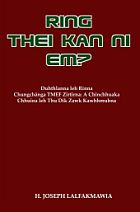Found this article while I’m searching for mizo pictures – Father
A lost tribe of (ancient) Israel may be living in … eastern India.
Perhaps that’s an overstatement. It would be more correct to say that there are people currently living there whose ethnography is too close to that of (ancient) Israel to be easily dismissed. This is the thesis of a book by Hillel Halkin I’ve just gotten around to reading entitled “Across the Sabbath River” (the title refers to a legend that the lost tribes live on the other side of a river that stops flowing on the Sabbath).
What is certain, is that Halkin has documented a group who say and believe they are descended from the lost tribes, who tell a tale of a migration from the Middle East, and who apparently have observed important Jewish holidays until very recently. They may not be descended from the lost tribes, but they certainly seem to have had contact with seminal Jewish practices that end with the Mosaic teachings.
Most people have had some exposure to the idea that some Jews went missing a long time ago. But it is at best a legend to most people, and a bit of biblical trivia for those who are more serious. But, it is often misinterpreted as having something to do with the exile in Babylonia of the 5th century (those exiles came back to Canaan), or the diaspora following the destruction of the second temple in 70 A.D. (the descendents of those people are today’s Jews). No, the missing tribes are really missing, and have been gone for a long time. It’s a lot more serious for Jews, who feel that part of them was taken away and has yet to be found.
Let’s establish the historical facts first. The old testament reports that after the Jews fled Egypt and resettled in Canaan they went through a phase dominated by affiliation to the twelve different tribes, a short period of unity, and then a period of division: two tribes into the more religiously serious southern kingdom of Judea, and nine into the northern kingdom of (ancient) Israel (the southernmost tribe of Simon seems to have disappeared all on its own). In the 8th century B.C., the Assyrian Empire began to pressure Israel. In the 730s they overran most of Israel, and in 722 conquered it outright. There are only 4 short passages about this in the old testament, and 3 note that the inhabitants of (ancient) Israel were removed to remote locations in Assyria.
This seems a bit of an odd story in contemporary America (other than it being an obvious source for some of the mythology underlying the 1970s television show Battlestar Galactica – yes, I admit to watching it in 1978, but not any more recent incarnations), but the removal of peoples in toto has been a common theme in Middle Eastern history until shortly before World War I. (A few years back I learned from a former Ph.D. student how many Circassians were forced from their homes on the northern side of Caucusus Mountains to settlements along the Hejaz railway by the Ottoman Empire.)
Non-bibical confirmation of this story started arriving in the 19th century with the discovery and translation of cuneiform tablets from ancient Assyria. These confirmed the biblical account, and gave numbers and locations of deportees. The locations correspond to places on the fringes of Mesopotamia – well within the Assyrian Empire, but quite far removed from Canaan. But those distances are small compared to the routine distances nomadic tribes traveled in early recorded history.
But the lost tribes are not there now. Where could they possibly have gone? There are many rumors: the Pashtuns of Afghanistan who claim to be descendents, the Falashas of Ethiopia, the Lemba of southern Africa, the Jewish colonies found in India and China by the first westerners to penetrate there, and many peoples in the Caucusus who bear more than passing similarities. There are other possibilities too: the lost tribes returned with those exiled by the Babylonians two centuries later, the lost tribes slowly filtered back to become the Samaritans of the bible (who still exist in minute numbers to this day, and practice a pre-rabbinic relative of contemporary Judaism), or they never returned but became the seeds of future monotheistic cultures throughout the Middle East.
Even so, how would we know a lost tribe if we found them? They would have to have some memory of old testament events or teachings. But, the books of the old testament do not appear to have been written contemporarily. A contemporary lost tribe should have some remembrance of the five books attributed to Moses. Then it gets dicier. Joshua, Judges and the pairs of Samuel, Kings, and Chronicles all refer to events before the exile of (ancient) Israel, but may not have been written for several hundred years afterwards.
What is clear is that a lot of nonsense has been written on the fringes of the Judeo-Christian west about the location of the lost tribes, and Halkin dismisses it easily.
“…As sometimes happens when reason wins a battle with religion, religion – or, rather, a sudden mutation of it – broke off all further contact with reason in its retreat.
But, this is just my preface; what about the book?
The book starts with Halkin accompanying a rabbi named Avichail. Avichail is regarded as a little bit of a kook in (contemporary) Israel. He services peoples around the world who might be the ten lost tribes. But as the book proceeds it becomes clear that Avichail is primarily interested in whether people are living as Jews today, and only secondarily interested in whether they are descendents of the lost tribes.
Initially, the author is in China (!). There are a people there in Szechuan called the Chiang. The claim to have migrated into China from Tibet to the west, they are monotheistic, call their god Ya-Weh, forbid graven images, and have a hereditary priesthood. Unfortunately, there are few traces left of the Chiang. They were there a century ago when the accounts were written, but their culture has now been erased by the communists.
Next they go to Thailand (!!). The Karens still live there and are easy to find. They too claim to have come from Tibet, through China, and south into Thailand. They believe in a God named Y’wa who created the Earth, but doesn’t interfere too much. Y’wa created the first man, and the first woman from his rib. They were set in a garden, and driven out after eating a forbidden fruit offered by a serpent.
Perhaps these accounts just show the influence of Judeo-Christian theology in these remote areas. Yet, the sources in question were written by the first westerners to go to those places. They appear to have tenous ties to the creation as presented in the first chapters of the Book of Genesis. So, the evidence is tantalizing.
Oh … and the Karens also say that men once tried to build a tower to reach the sky. Halkin argues that this bit of similarity is probably possible through chance. But, the Karens also believe that the destruction of this tower led to the linguistic and geographic dispersion of various people. I didn’t find it implausible when he concluded that “this wasn’t the kind of imaginitive lightning that strikes twice”. So, now the trail is getting a little deeper into the Book of Genesis.
Then the group goes to Mizoram – a province on the eastern border of India with Myanmar (!!!). It is inhabited by a people known as the Kuki-Chin-Mizo depending on their location. The Mizo in Mizoram, the Kuki in the neighboring province of Manipur, and the Chin across the border in Myanmar. The Mizo and Kuki have been practicing their interpretation of Judaism since the 1950s. Here the story veers away from Avichail. There is definitely a group of people trying to live as Jews (and being successful enough at it that some are accepted for emmigration to Israel under the law of return). But, it is also a fact that this is a development of the last 50 years. Avichail is concerned with correcting their bastardized Judaism.
On the other hand, the author becomes fascinated with their reasons for pursuing Judaism. They claim that the religion that they practiced until a fairly recent obliteration by Christian missionaries (between 1894 and the 1950s) was in fact Judaism. They feel that they are returning to their roots. They even claim descent from a specific lost tribe – that of Manessah.
Fair enough … but what is the evidence?
It begins with the absurd. The national consciousness of this issue is so high that the province holds a referendum in which they vote themselves members of a lost tribe. And they have what sounds like a children’s song with the line “We are entering Zion”. Halkin is nonplussed.
Then he digs out a few old people with some distant cultural memories. In particular, they remember that circumcision was practiced before being suppressed by the missionaries. And it occurred on the 8th day after birth as directed in the Pentateuch. They also mention (spottily) ten other parallels with the Pentateuch. Halkin becomes more curious. But, there are other parts that are missing: they do not observe a Sabbath, and they have no dietary restrictions.
However, they also produce a chant which lists the places they have lived, starting in Egypt, then Zion, Afghanistan, Tibet, China, and Burma. The latter part seems implausible without a good atlas. This shows how the Himalayas run east-west with long valleys and plateaus between them. And dropping from their eastern slopes are the Yangtze along which the Chiang live, the Mekong in the next valley to the south, the following valley contains the Salween which runs down into Thailand through the land of the Karens, and another valley to the Bhramaputra that runs past Burma and down into India.
But, all of this is unconvincing, and by 200 pages into the book Halkin is ready to give up the hunt. Everything he has seen could just be cute copying of the old testament. But it really isn’t the old testament; it’s the very old testament – there is nothing here from after the Pentateuch. If they were picking this up from Christian exposure to the bible, one would think they’d adopt some of the more popular old testament narratives, like Job and Daniel. Now the trail becomes hotter.
He meets Liana, a “practicing” priest of the old religion from a remote Chin tribe. After a considerable time building up trust, Liana tells Halkin about a ceremony he performs once a year to cleanse his village of their sins. It bears striking resemblence to Yom Kippur. And, it involves a lot of Mosaic behaviors that probably would not be casually pursued.
Then a will of a priest of the old religion is produced and authenticated to prior to the revival of “Judaism” in the 1950s. It mentions the biblical figures Tera, Abraham, Isaac, Jacob, and Manessah. It mentions the biblical places of Egypt, a Big Red Water, Sinai, the Place of the Covenant, Zion, and so on.
And lastly, Halkin goes to visit the Kukis. Halkin has been thinking that the best chance of finding evidence will be amongst the more primitive Chin, and the middling Mizo. The Kukis are too cosmopolitcan and exposed to the outside world to harbor much information. But they do.
Halkin meets a Dr. Khuplam. He has been practicing ethnography as a hobby since the 1940s. Dr. Khuplam produces an old song that refers to a people being carried off from their homes … by someone whose name bears a striking resemblence to Shalmaneser, the biblical name given to the Assyrian king Sulman-asared V.
Dr. Khuplam also recites songs in the native language that end with the one word line “selah”. They have retained this word and another from some older tongue. This word is found in the Books of Psalms and Habbakuk, but its meaning has been lost to modern Hebrew. But Dr. Khuplam knows that it is just a direction to repeat the entire verse. Dr. Khuplam’s songs also contain words he doesn’t know. In particular, “aborizah”. But, modern Hebrew translates this literally as “O God the creator”, and it has the double meaning that “a bargain is a bargain [and you must accept the outcome]“. The meaning fits where it occurs in Dr. Khuplams stories.
And lastly, Dr. Khuplam produces very old men who remember when they used to celebrate a special holiday every Spring. In it they took rice and made it into unleavened bread, which they ate as part of holiday. This, among a people, who understand what yeast is for and what it does, but who do not make bread at all.
So, there you have it. These people say they came from the Middle East, they say they are descendents of the tribe of Manesseh, they have a tale of being taken from their homes by a foreign conquerer, they have practiced circumcision on the 8th day after birth, and they have holidays that mimic Yom Kippur and Passover. Further, they retain at least two words that are recognizable to a modern Jew.
How does Halkin reconcile all this? He does not claim that these people are actual physical descendents of the lost tribes. What he does claim is that their oral history points to a specific subset of the tribe of Manesseh, through his son Gilead and grandson Ulam, to a people who lived on the east side of the Jordan river at the base of Mt. Hermon. Assyrian tablets indicate that Shalmaneser took 13,500 hostages from this area, around 732 B.C., eastwards to Mesopotamia. Here the story dims. It was standard practice to recruit the men of exiled peoples into military units that garrisoned areas as far fom home as possible. And the Kuki-Chin-Mizo say that they went through Afghanistan, which was part of Alexander’s conquests, and they retain some words (including one version of Egypt) that appear to have their source in Greek. Their songs also mention cities further east along the Silk Road that passed through Kabul on its way to China. And from their, the trail is clearer, as both their oral history and regional ethnography confirm migrations down the river valleys that rise in Tibet into much of southeast Asia.
Halkin concludes that the Kuki-Chin-Mizo may be physical descendents of the lost tribes, but they don’t need to be. But, at a minimum, it appears that they came in close enough contact with them to retain a link to the Jews of (ancient) Israel. And that, would also explain where the Chiang and the Karen picked up their Mosaic tendencies. Could they have gotten that far, and remembered anything over 2,700 years? This seems implausible, yet today’s Jews retain a vivid cultural memory 1,900 years after they were dispersed. And, within a thousand years of that they had dispersed over a longer range than the supposed travels of the Kuki-Chin-Mizo.
It’s quite a detective story, and I have to say that it seems both plausible, and reasonably and skeptically presented. It isn’t an academic work, but for a piece of journalistic non-fiction, it certainly seems more thorough and less preposterous than a great deal of writing in the social sciences. I highly recommend it!
Similar Posts:
- ‘Lost Jewish Tribe’ in India Soon To Move To Israel
- Zos Means Zosef and We Are Ephraim Tribe
- Israel likely to admit Jews from Northeast India
- Pi Zaii hnenah certificate hlan
- Israel, Oh Israel…Yawn






 :-D
:-D



August 6th, 2006 at 11:32 pm
a thui eeeee.. chhiar zawh a har
Report this comment
August 6th, 2006 at 11:54 pm
very very interesting ..
Report this comment
August 7th, 2006 at 1:24 am
Hmmm…chui chui ralah chuan eng hnamah poh kan in chhui lut thei vek om e. After all, we’re all decendants of Adam & Eve, the first man and woman God created. (If you believe in ‘creation’ rather than ‘evolution’ ;))
Btw, “Szechuan” ti a a ziah khi “Sichuan” ti a sipel zok tur ani e. It’s one of the 34 provinces in China.
Report this comment
August 7th, 2006 at 7:34 am
pu ben does it mean before every reply i have to enter my name i find the new site very complicated i am computer illiterate so what do i do ?
Report this comment
August 7th, 2006 at 7:43 am
kha ka log in chuan ka hmin a lang leh toh lo
Report this comment
August 7th, 2006 at 8:34 am
I for one would prefer to be lost tribe of United States or Singapore. What is so special in claiming (against scientific odds which suggested two years ago that DNA tests proves NE Indians have no links with Israeli tribes) that we are an Israeli tribe? What is wrong in staying as a Mizo ? As a Christian ? If they are not satisfied, they will not ne happy as an Israeli tribe either.
Report this comment
August 7th, 2006 at 8:43 am
shit man buddy this in kinda complicated !! i miss the old site
Report this comment
August 7th, 2006 at 12:50 pm
Ka chhiar buai peih vel lo. Soi fel chi pawh a nih love. Lunch atan enge ka ei ang tih lam zawk a ni ka ngaihtuah.
Report this comment
August 7th, 2006 at 1:43 pm
Where? Link?
Report this comment
August 8th, 2006 at 12:10 am
ho e…keipawh ka chhiar kan vel mai mai.engtinnge pawisa tam tawk ka thawh chhuah theih ang tih kan ngaihtuah daih teng.
Report this comment
August 8th, 2006 at 12:14 am
lovingangel, chu tiang te chu har vak hlei nem
Bank rok la ni mai lom
Thingthlang lam bitum deuh la…hei hmaaaaaana mi Longtlai mikha (?) kha poh an la chhui chhuah loh hi
Chuan he ka kong kohhmuh che avang hian 25% ka chang ang
Report this comment
August 8th, 2006 at 2:58 am
A va interesting ve a,israel kan nih tak tak chuan ka pem ve nghal dawn.kei chu kan nih ka ring.chu mi ram a tang chuan kan kal thla a.chu mi ram chu kan kan a.kan kal kual a.tih vel history hnam dang te zing ah nei an awm ngai lo.keini mizote chiah hi kan ni.hman lai a kan pi leh pu ten mizoram an lo luh hma khan khawi a tang in nge kan lo kal tih hi..ngaihtuah tham chu a tling ve a lawm.Chhinlung a tang in kan lo chhuak tih ringawt hi chu..rin ringawt chi pawh a ni lo.tu emaw hnam a tang a chhuak chu kan ni a lawm..hman lai khan juda ho kha an ram a tang in hnawh chhuah an nia chhim,hmar, thlang leh chhak ah an kal a.kei chu kei ni hi kan ni an ti a nih chuan.thil rin thlak ber pawl niin ka hria…Ka lawm e..:)
Report this comment
August 8th, 2006 at 3:48 am
Pu Chhanhima leh Pu Biaksiama in chapchar kha i en lo ni mo???
Pu Chhanhima’n dangnal taka an soi char2 hi chuan “E, kan li nih chu” tih mai thieh hian a lang a
Mahse Pu Biaksiama’n muang chep chopin a thusoi an hnial thla hmak2 mai chu…ngaihnom lutuk rongot..
An thil hriat hrim2 an han soi poh kha a ngaihnom in interesting top
Khutiang ram buaiah te i pem chak
Chutia i pem chak te chuan…Israel ka ni e..ti la ni mai lom
Report this comment
August 14th, 2006 at 6:32 pm
kum sanghnih aia tam hnuah chuan, leh ram hrang2 vahkual hnuah chuan kan tihdan thrin pangngaite chu kan theihnghil remrum tawhmahnale….engpohnise kei chu israel thlah kan lo ni anih chuan lawmawm kati..kanlonilo anih pohin thlaraulamah israel kan ni tho alawm a pawi chuanglo…
Report this comment
December 8th, 2006 at 1:12 pm
Pu Biaksiama hi tun thil-ah hian a va ngawi ta ve maw le. Pu Chuauthuam te ho nen hian tang tlang in han che leh se a ngaihnawm lehzual tur a nia leh.
Report this comment
December 8th, 2006 at 1:15 pm
I duh tak tak chuan Judaism ah luh phawt a ngai. Kan ni lo ti awm mahse Israel Chief Rabbi Shlomo Amar meuh khan an ni a ti tawh a. Ni a in ngai a piang chu lawmtakin Israel sawrkar chuan a hruai thla zel dawn alawm. Ni lo a inngai chu hruai thlak luih phet thu awm hek lo le.
Report this comment
December 8th, 2006 at 1:15 pm
I ti dik khawp mai
Report this comment
December 8th, 2006 at 1:16 pm
Taima takin hna thawk la a ni mai alom
Report this comment
October 22nd, 2011 at 7:54 am
Kalo la chhiar miahlo nia mawle he post kher kher hi hairehai
Report this comment